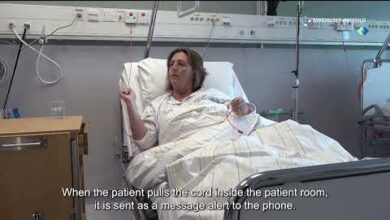Northern Ireland nursing workforce grows by 23% in a decade

The registered nursing and midwifery workforce in Northern Ireland has grown by 23% since 2014, latest data has revealed.
The Department of Health in Northern Ireland has published details of its Health and Social Care (HSC) workforce census for 2024.
“It is clear that the numbers of nursing staff are not rising in line with the current demand”
Rita Devlin
The publication provides analysis of staff in post across the majority of HSC hospital community and social services.
As of 31 March 2024, the HSC employed 65,984 whole-time equivalent (WTE) staff – an increase of 2% compared to the previous year when it was 64,688.
Just over a quarter (27%) of this workforce were from the registered nursing and midwifery staff group, which stood at 17,746 WTE.
With 384 more WTE staff, the registered nursing and midwifery workforce experienced the largest annual increase in staff numbers compared to 2023 – a rise of 2%.
This group also saw the largest increase of WTE staff over a five-year period – with a 16% increase in staff since 2019.
Overall, the registered nursing and midwifery workforce has grown by 23% since March 2014 – when it had 14,428 WTE staff.
Breaking it down by Agenda for Change bands, 50% of nurses and midwives were working at band 5, while 45% were working in bands 6-7.
Some 5% of registered nurses and midwives were working in bands 8 or above.
The census revealed that just over half (54%) of all registered nurses were working as acute or general nurses.
Meanwhile, 9% were mental health nurses and 2% were learning disability nurses.
District nurses and paediatric nurses made up 5% of the workforce, while health visitors made up just 3%.
However, in contrast, the nursing and midwifery support workforce saw a 2% decline in staff, with 4,426 WTE staff in March 2024 compared to 4,500 in March 2023.
This means that nurse support workforce numbers have now dropped below pre-pandemic levels, when there were 4,447 WTE staff in 2019.
Across all HSC organisations, Belfast HSC Trust was the largest overall employer of nursing and midwifery staff, making up 32% of the overall workforce (7,052 staff).
Both Western HSC Trust and Southern HSC Trust employed 18% of the WTE nursing and midwifery staff, while both Northern HSC Trust and South Eastern HSC Trust employed 16%.
The census showed that the majority (91%) of nursing and midwifery employees were female, while 9% were male, which largely mirrors the picture for the UK as a whole where 10% of nurses are male.
The median age of registered nurses and midwives was 39 years and for nursing and midwifery support staff it was 44 years.
The data broke down age and showed that over half (51%) of registered nurses and midwives and 39% of nurse support staff were under the age of 40.
In addition, 13% of nursing and midwifery staff and 24% of nurse support staff were aged 55 years and over.

Rita Devlin
Responding to the publication of the census, Rita Devlin, executive director of the Royal College of Nursing Northern Ireland said: “While on paper there is rise in the numbers of nursing staff in Northern Ireland, no nurse that I know will say that it feels like there are more staff.
“When patient numbers and demand is so high and the service is under such pressure, it is clear that the numbers of nursing staff are not rising in line with the current demand.”
Ms Devlin noted that the college was “concerned about the stagnation and decline of registered nurses in some areas of practice”.
For example, she said the learning disability nursing workforce has fallen by 25% since 2011.
“It is crucial that we address these issues and ensure we have a workforce that is fit for purpose,” argued Ms Devlin.
“In addition, we are seeing the numbers of nursing support worker staff fall. These are extremely valuable members of the workforce who provide essential care to patients.”







